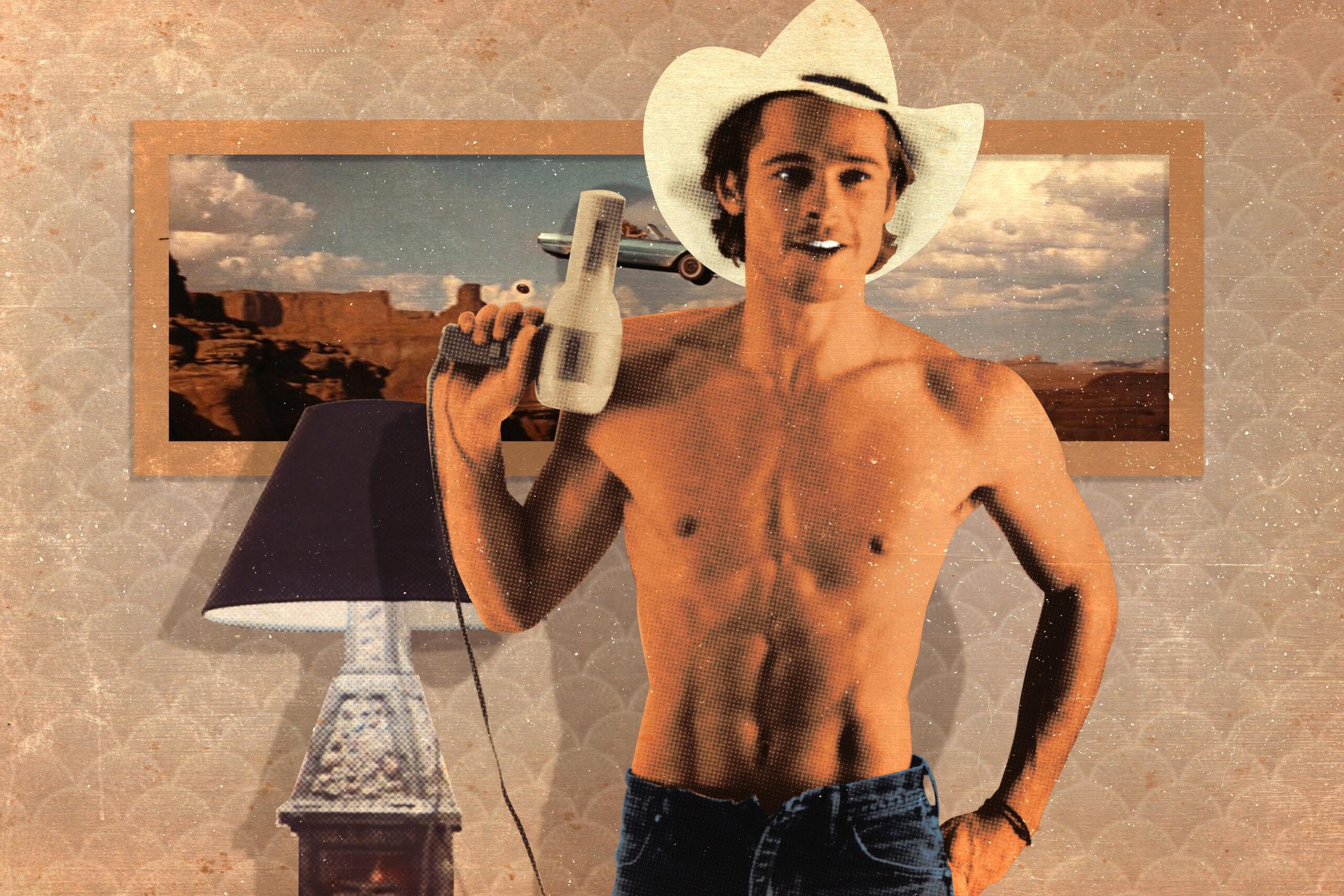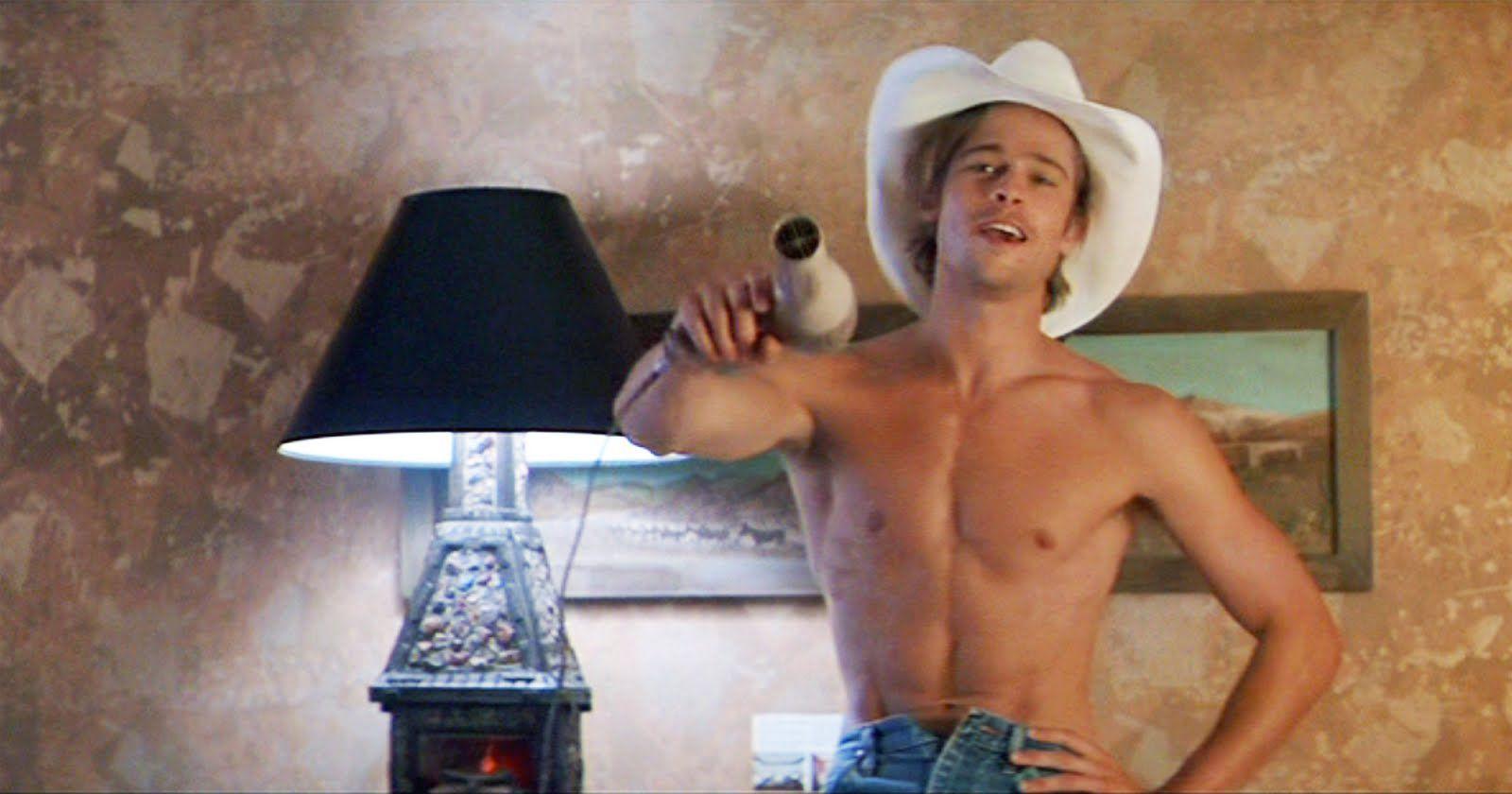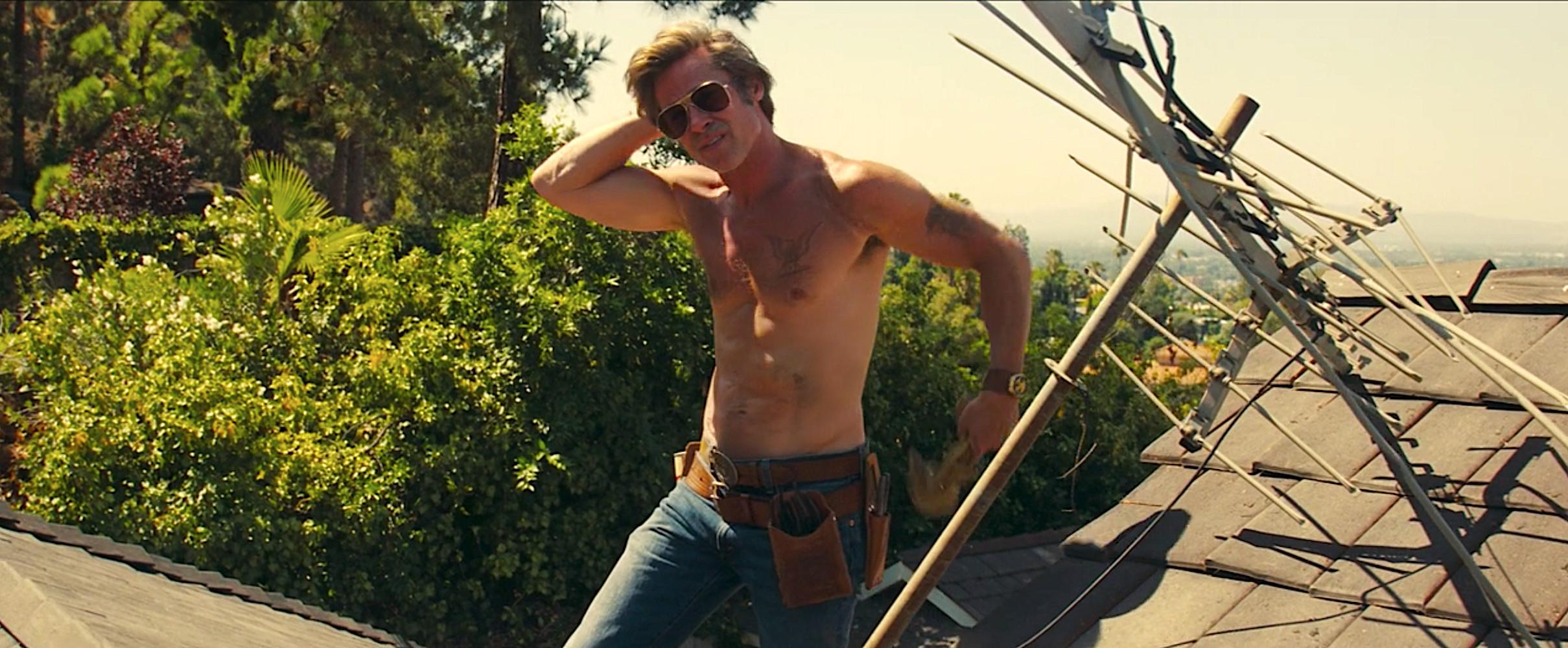Brad Pitt Took His Shirt Off in ‘Thelma & Louise.’ Men Were Never the Same.
For more than a decade, the ideal man was a muscle-bound warrior more focused on heroism than human connection—Schwarzenegger, Stallone, Van Damme. Then Brad Pitt showed up in 1991 with a blow-dryer and a cowboy hat.
2020’s summer blockbuster season has been put on hold because of the pandemic, but that doesn’t mean we can’t celebrate the movies from the past that we flocked out of the sun and into air conditioning for. Welcome to The Ringer’s Return to Summer Blockbuster Season, where we’ll feature different summer classics each week.
Summer movies promise escapism and adventure; once upon a time (and now once again), you would go see them at drive-ins on a hot night, with your date or your best friends. That’s why it makes sense that the warmest season of the year is the ideal time for road movies.
Thelma & Louise, released on Memorial Day weekend in 1991, has all the key features of a road movie—two friends going on a trip, a car, sunny roads, some good and some bad encounters, and incredible vistas—but it isn’t quite escapist. Thelma (Geena Davis) and Louise (Susan Sarandon) aren’t simply going away for a weekend: Their trip isn’t as much about the journey as it is about the destination. Without being fully aware of it, they are running away from the miserable lives that have been handed down to them, and searching for their lost freedom.
Even before Thelma has packed her suitcase, an obstacle comes in her way: She knows her husband, Darryl (Christopher McDonald), enough to not bother asking him for his permission to leave for a few days. She has to literally flee her own home in order to have her holiday. Although Louise’s status as a single working woman seems to grant her more independence, her departure is a precipitated escape, too: She has to rush after her shift at the diner, and tries to call her unreliable boyfriend, Jimmy (Michael Madsen). The oppressor has been identified: All around these women, men are imposing their own expectations and desires, so that when Thelma and Louise want some time for themselves they have to steal it away, like criminals.
Thelma & Louise has left its mark for being one of the very few Hollywood movies centered on two fully developed female characters who don’t fight for a man but are, instead, models of genuine friendship—something that wasn’t and still isn’t deemed bankable. (The recent wave of female reboots has overwhelmingly been in the action genre, as though actresses had to copy a preexisting, male-dominated type of cinema in order to be considered worth watching.) But that film was well aware of its precarious position not only as a female-driven story in a sea of macho movies, but also as a story focusing on people that society at large dismisses.
Director Ridley Scott and writer Callie Khouri emphasize the challenging context in which Thelma and Louise evolve. This, in turn, gives the two characters real dimension and a deeper, more complex psychology than is often allowed of female protagonists. They aren’t simply angry women who suddenly rebel against the patriarchal world: They have lived in it for too long, and they still hope for the kind of romantic connection that society has advertised to them. The cruel paradox of the patriarchy is that, in empowering men and weakening women, it often makes the latter feel ever more dependent on the former. Throughout Thelma & Louise, the two women therefore encounter many men who help delineate that context and make them realize, through tragic trial and error, that the only way through is out. With the journey of its lead characters, the film paints a comprehensive picture of the female experience. But at the same time, it also portrays what being a man meant in 1990s America.
Hollywood movies up until Thelma & Louise were typically all about men, or rather their fantasies of power, control, and destruction. Although Sylvester Stallone made his name playing a sensitive boxer, he went on to define his persona by his physical aptitude more than by his big heart. The action movie boom of the 1980s encouraged a violent, virile, and unemotional kind of hero: Terminators, Rambos, and Kickboxers. Stallone, Arnold Schwarzenegger, and Jean-Claude Van Damme were popular for their incredible physiques (and sometimes derided for their acting skills), which helped equate masculinity with insensitivity, as well as asexual but to-be-looked-at male muscles. The female character came not second, but third, after the villain. Her personality was usually limited to contradicting the hero until she inevitably fell for him, even as there often seemed to be more erotic energy between the protagonist and his nemesis.
In a reversal of this usual dynamic, it is the men in Thelma & Louise who are more caricatural and superficial than the women. Yet one of these men in particular stands out—precisely for his superficiality—and marks a shift in the modern conceptualization of masculinity. Brad Pitt used his skills as a jeans model to portray J.D., a charming, cowboy-hat-wearing drifter the women meet as they flee the police.

Thelma & Louise is intelligent enough to avoid generalizations about men and clichés about women, so a day after getting threatened with rape by Harlan (Timothy Carhart), a man Thelma had just met and who Louise proceeded to shoot to death, Thelma is shown to be capable of feeling attracted to J.D.: There is no blaming the victim here. Even more gratifying is that Thelma is allowing herself to go after what she wants, something neither the paternalistic Darryl nor a more conservative screenwriter would have granted her. This is the difference between her encounters with Harlan and J.D.: This time, the feeling is mutual, and the woman’s desire is part of the equation.
What attracts Thelma to J.D. is, chiefly, his very good looks. His body is sculpted like that of a gladiator, an old-fashioned magazine model, or an action star of the 1980s, although he is skinnier and younger, pointing to a new, leaner generation. But he is also a smooth talker who seems to genuinely care about Thelma’s terrible married life: He manages to sound caring when he tells her that Darryl is clearly awful. Even when he admits to making a living through robbery, he remains a gentleman: “I’ve always believed that done properly, armed robbery doesn’t have to be a totally unpleasant experience,” he says calmly. He never hurts people, using his looks and politeness instead of physical force. He views his robberies like he views his sexual encounters: He wants sex to be a collaboration and a mutually pleasant experience.
J.D. appears as the perfect antidote to all the toxic masculinities that Thelma and Louise encounter on their journey. Where Darryl was selfish and uncaring, J.D. listens and talks only when his opinion is requested. And unlike the inconsistent and avoidant Jimmy, Pitt’s character isn’t afraid of talking to Thelma about serious matters, and he clearly shows interest in her, reappearing on her road and at her doorstep. While Harlan played nice only to get Thelma to be alone and defenseless with him, J.D. enjoys all the preliminaries and doesn’t need to force himself on her to get into her bed.
But the scope of J.D.’s corrective power extends far beyond the film he appears in. He also represents a shift from the male ideal that cinema at large had promoted until the early 1990s. Before J.D., this type of sculpted body was depicted as an action film body, an ideal of physical strength meant to do and break things. And although often covered in oil or sweat, that body was sexualized only from a distance, its eroticism countered or transfigured by action scenes: the aesthetic appeal of Schwarzeneger, Stallone, or Van Damme was justified by the incredible feats of strength they performed.
J.D.’s sculpted body, on the other hand, isn’t for action, but for show. Its sexual appeal is made obvious through the devouring eyes of Thelma and the work of cinematographer Adrian Biddle. J.D. is attractive not for his physical appearance but for his sexual prowess, and the visual pleasure he freely offers. His emotional intelligence is also a new feature of the ideal male form: The sculpted action man was not an emotional body; he only had to manage falling buildings or women in physical danger, not their feelings. J.D.’s embracing of his superficial appeal and of people’s emotions makes him sexually liberated—and liberating. He wants Thelma to be free so that they can have a good time together.
Yet Thelma & Louise is neither a dystopian film nor pure fantasy, and it doesn’t offer up J.D. as the cure to all macho ills. In a depressing but also somewhat life-affirming twist—because it’s so true to life—J.D. turns out to be crooked too. He may have been honest to Thelma about his criminal occupation, but he remains a criminal. After a night of intense, furniture-breaking, almost parodically good sex, J.D. slips away from Thelma’s bedroom with all the money that Louise had obtained for their escape to Mexico. His altruism is revealed to be superficial and his charm empty, self-serving, and heartbreaking. While the action men could do things, often to save their loved ones or the entire world, J.D. is nothing but smoke and mirrors and cares only about himself.
J.D. revealed that both looks and manners can be deceiving, and that the road to healthy masculinity wouldn’t be a simple reversal of traditions—behind his perfect appearance and empathy hides a man just as mediocre, self-centered, and manipulative as the senseless and selfish macho men who had so far shaped ideal masculinity. The change has to be deeper than surface-level: It has to come from within.
Twenty-eight years after Thelma & Louise, Pitt played another good-looking man and one whose muscles are, again, only for show: In Once Upon a Time … in Hollywood, he is a stuntman, and an old one, too. Director Quentin Tarantino also hints at the fact that, like J.D., Cliff Booth may not be as respectful toward women as he lets on. In 2020, the traditional conceptualization of the ideal male still has to be challenged and questioned. But Cliff wouldn’t have existed without J.D. and the wave of complex, disenchanted visions of the masculine ideal that he spurred.

After Thelma & Louise, Stallone and Schwarzeneger themselves began acknowledging the superficiality of their physical power and the ridiculousness of their size, often in family comedies—Last Action Hero, of course, and also True Lies and Oscar—but also in slightly more serious fare, trying, with limited success, to give a soul to their huge bodies (Eraser, End of Days). Harrison Ford, meanwhile, began playing with the persona of the sexy, selfish but righteous adventurer he had forged in the 1980s with the Indiana Jones series. Already in 1988, he had signaled his interest in more flawed and interesting male characters with Working Girl: His character, Jack Trainer, is shy when countless secretaries watch him take off his shirt in his office, but he lets them enjoy that moment; he is also deeply ashamed and unlikable when it is revealed that he has a tendency for sleeping with and manipulating powerful women who can help his career. In The Fugitive, Ford’s physical prowess is tested along with his male dominance—instead of Thelma and Louise, he is now the one running away from justice.
So what became of the new cinematic masculine ideal? With the rise of modern romantic comedies came a new perfect gentleman: Tom Hanks appeared as a sensitive, serious, charming young man, without the body of a jeans model but gifted with a sense of humor and of a kind of righteousness that only Jimmy Stewart ever had. He never set foot in the action genre, but other actors gave it a new, more psychological and honest flair. Tom Cruise in the Mission: Impossible franchise, and Matt Damon in both dramas and stunt-heavy movies, were updated versions of Pitt’s J.D.: They had flaws, but they acknowledged them; they were physically powerful, but didn’t always show their bodies, especially not naked. Their internal lives and struggles with doing the right thing replaced the physical fight for justice and recognition.
But it also made them less sexy: Paradoxically, as time has gone on, the male ideal in cinema has been desexualized. Hanks, Cruise, and Damon have rarely directly used their sex appeal in their roles. Some exceptions may point to a return to Stallone-style big men—all the Chrises, but also the cast of the Magic Mike series, whose characters are explicitly presented as relics from the past—but they are few among many more unique, sensitive, tender faces. Mark Ruffalo, Robert Downey Jr., and Will Smith all represent a softer kind of masculinity; perhaps more adventurous and rebellious than Hanks, but still sanitized.
In more recent years, as views on gender identity have finally started to relax and become less constrictive, masculinity in cinema has been more questioned and reshaped than ever. Timothée Chalamet may not play perfect boys, but he plays “beautiful” ones: He is perceived as such, flaws and all, inside and out. Lucas Hedges is, arguably, the new, updated version of Tom Hanks: Incredibly talented and versatile, he, too, refuses to be limited to old labels of what a man should be, and instead pushes the limits of every preconceived idea about masculinity. While Chalamet played a fuckboy in Lady Bird (a more modern, more detached version of J.D.), Hedges was the young man who discovered his homosexuality while dating a girl who didn’t chastise him for it.
When he steals Thelma and Louise’s money, J.D. doesn’t expect to eventually feel shame for it. But Hal (a tender Harvey Keitel), the policeman chasing the women, makes him realize the terrible consequences of his actions. The look on Pitt’s face in that moment is both infuriating and hopeful. It means that he understands what the generous Hal is telling him. And that perhaps, one day, a good man may not be so hard to find.